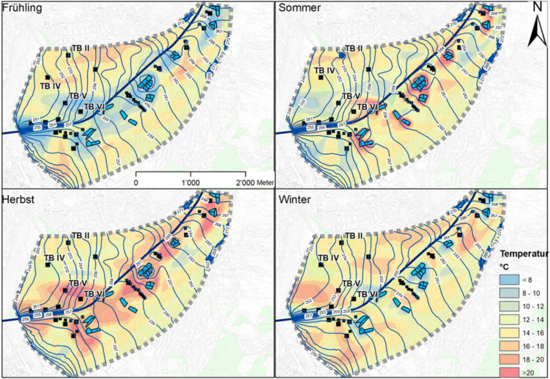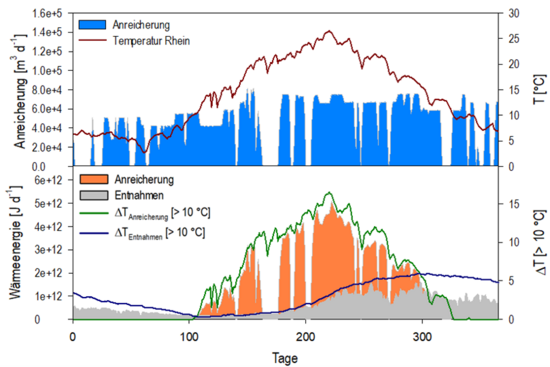Energetic potentials & artificial groundwater recharge
For various aquifers in the Basel area, concepts for MAR (Managed Aquifer Recharge) and MSWR (Managed Surface Water Recharge) have been developed on commission of the Swiss Federal Office for the Environment (FOEN). As part of the research project the energy potential of the thermal use of surface water for artificial groundwater recharge was investigated. The energy potential for the thermal use of surface water for (A) artificial groundwater recharge (MAR) and (B) regeneration of "heated" surface water (MSWR) was demonstrated for the various study sites in the Basel area.
The research work comprised two work packages. Work package WP1 focused on investigations to understand the processes, including hydrological and thermal modeling of discharges and temperatures of the surface waters Rhine, Wiese and Birs as well as hydrogeological heat transport modeling of the groundwater systems in the Lange Erlen (Figure 1), the Hardwald and in the area of the Aesch recharge plant in the lower Birs valley. Work package WP2 dealt with the development of concepts for Integrated Water Resources Management (IWRM) for the various study sites in the Basel area.
As part of the research work, the scientific basis for the specific technical challenges in the operation of MAR & MSWR was developed, which will ultimately allow the transferability of the developed tools and IWRM concepts for application-oriented resource management to be discussed against the background of climate change and water supply planning. On the one hand, possible applications of MAR as strategic groundwater recharge could be discussed and remediation measures for the regeneration of heated aquifers and the thermal use of artificial groundwater recharge with comparatively "cold" surface water (winter months) could be discussed for all study sites (Figure 2). On the other hand, for the study site in the lower Birs valley, strategic groundwater recharge in times of water surplus during medium and flood situations for drought periods was evaluated.
As part of the research work, the scientific basis for the specific technical challenges in the operation of MAR & MSWR was developed. The innovation of the research project lies above all in the connection between the hydrology of surface water and the management of groundwater resources as well as issues relating to "water" and "energy". The process understanding required for this should make it possible to capture the complexity of the system components and their interaction.
Commissioned by: Federal Office for the Environment (FOEN)
Project duration: 2020 – 2021
Jannis Epting, Annette Affolter, Stefan Scheidler

Figure 1: Hydraulic and thermal groundwater regime for the different seasons in the Lange Erlen, in spring (1st of April), summer (14th of July), fall (4th of October) and winter (3rd of January)

Figure 2: Derivation of the theoretical thermal potential from the recharge and abstraction water from the drinking water wells in the Lange Erlen, shown for 2018. Top: Recharge volumes and temperature profile of the Rhine. Below: Extraction of thermal energy from the recharge and abstraction water, shown together with the temperature differences of the recharge and abstraction water (mean value of all wells) at 10 °C.
Quick Links
Social Media
